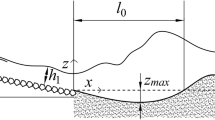Abstract
The effect of sediment transport on both morphology and energy dissipation in presence of non conventional stream rehabilitation structures, such as block ramps or rock chutes, is a not well explored topic on hydraulic engineering. Namely, in normal functioning conditions, these types of structures are generally located in mountain rivers, which are characterized by an elevated sediment transport which can be deposited and trapped between the rocks constituting the ramp. This causes a change in the bed roughness and in the energy dissipation process that is present on a block ramp. This occurrence was experimentally investigated at the Hydraulic Laboratory of the University of Pisa. Different experimental conditions were tested and the main hydraulic and geometric parameters controlling the filling phenomenon and its effects were highlighted. Namely, it was experimentally proved that both the median diameters of the filling material and of the ramp blocks, the ramp slope and the discharge are the most relevant parameters governing the ramp filling. Thus, experimental formulae were derived to foresee the ramp morphological changes and the interaction between the filling process and the geometric and hydraulic parameters. Moreover a comparison of the energy dissipation on block ramp was conducted and the energy recovery in presence and absence of filling material was compared.
Similar content being viewed by others
References
Ashida, K. and Bayazit, M. (1973). “Initiation of motion and roughness of flows in steep channels.” Proceedings of the 15th IAHR Congress, Istanbul, Turkey, Vol.1, pp. 475–484.
Bathurst J.C., Graf W.H., and Cao, H.H. (1987). “Bed load discharge equation for steep mountain rivers.” Sediment transport in gravel bed rivers, C.R. Thorne, J.C. Bathurst and R.D. Hey, eds., Wiley, New York, Chap. 15, pp. 453–491.
Chiew, Y. and Parker, G. (1994). “Incipient sediment motion on non horizontal slopes.” J. Hydr. Res., Vol. 32, No. 5, pp. 649–660.
Coleman, N.L. (1967). “A theoretical and experimental study of drag and lift forces acting on a sphere resting on a hypothetical bed.” Proc.12th Congress IAHR, Fort Collins, Col., Vol. 3, pp. 185–192.
Graf, W.H. and Suszka, L. (1987). “Sediment transport in steep channels.” J. Hydroscience and Hydr. Engng., Vol. 5, No. 1, pp. 11–26.
Iwagaki, Y. (1956). “Fundamental study on critical tractive force.” Trans. JSCE, Vol. 41, pp. 1–21.
Pagliara, S. and Chiavaccini, P. (2006). “Energy dissipation on block ramp.” J. Hydr. Engng., Vol. 132, No. 1, pp. 41–48.
Pagliara, S. and Chiavaccini, P. (2007). “Failure mechanisms of base and reinforced block ramps.” Journal of Hydraulic Research, Vol. 45, No. 3 (2007), pp. 407–420.
Rice, C.E., Kadavy, K.C., and Robinson, K.M. (1998). “Roughness of loose rock riprap on steep slopes.” J. Hydr. Engng., Vol. 124, No. 2, pp. 179–185.
Robinson, K.M., Rice, C.E., and Kadavy, K.C. (1995). “Stability of rock chutes.” Proceedings of the ASCE Water Resources Conference, San Antonio, TX, pp. 1481–1485.
Schoklitsch A. (1983). Handbuch des wasserbaues, 3rd Ed., Springer-Verlag, Vienna, Austria.
Sheilds, A. (1936). “Anwendung der Anhlichkeitmechanik und Turbulenzforsschung auf Geschiebebewegung.” Mitteilunger der Preussischen Versuchsanstalt fur Wasserbau und Schiffbau, Heu 26, Berlin.
Smart, G.M. and Jaeggi M. (1983). Sediment transport on steep slopes, V.A.W., Mitteilungen 64, Hydrologie und Glaciologie, ETH, Zurich, Switzerland, p. 191.
Suszka, L. (1991). “Modification of transport rate formula for steep channels.” In: Armanini A. and DiSilvio G. (eds), Lecture Notes in Earth Sciences, Springer-Verlag, Berlin, pp. 59–70.
White, C.M. (1940). The equilibrium of grains on the bed of a stream, Philosophical Trans. Royal Soc., London, 174A, pp. 322–338.
Whitehouse, R.J.S, Soulsby, R.L., and Damgaard, J.S. (2000). “Discussion on inception of sediment transport on steep slopes” by Lam Lau, Y. and Peter, E. J. Hydr. Engng., pp. 553–555.
Whittaker, W. and Jäggi, M. (1996). “Blockschwellen.” Mitteilung 91 Versuchsanstalt fur Wasserbau, Hydrologie und Glaziologie. ETH Zurich, Zurich, Switzerland in German.
Yang, C.T. (1973). “Incipient motion and sediment transport.” J.Hydr. Div., Vol. 99, pp. 1679–1704.
Author information
Authors and Affiliations
Corresponding author
Rights and permissions
About this article
Cite this article
Pagliara, S., Palermo, M. & Lotti, I. Sediment transport on block ramp: Filling and energy recovery. KSCE J Civ Eng 13, 129–136 (2009). https://doi.org/10.1007/s12205-009-0129-1
Received:
Revised:
Accepted:
Published:
Issue Date:
DOI: https://doi.org/10.1007/s12205-009-0129-1




